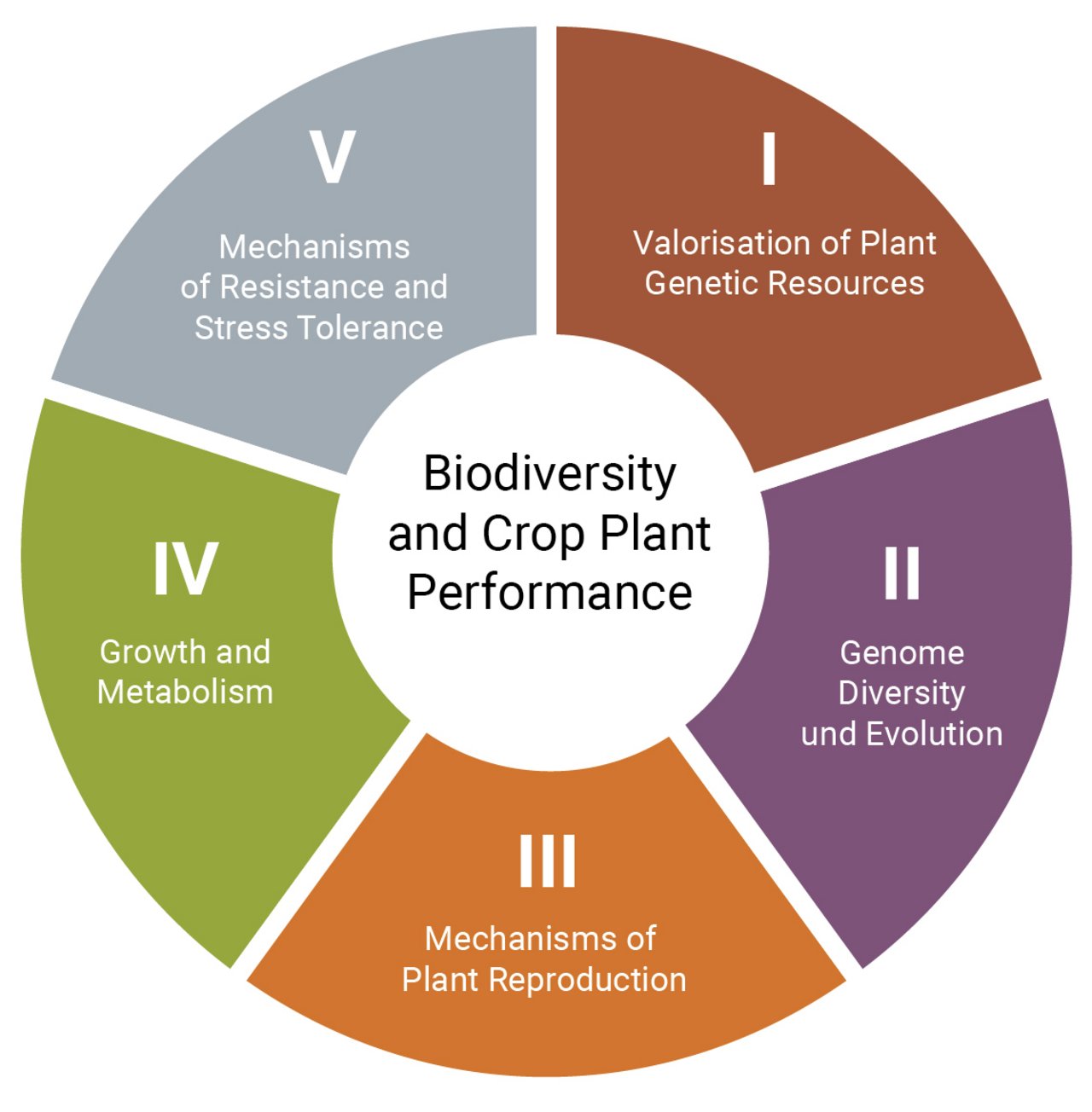Research Themes
Research Themes
The largely disciplin-oriented programmes adrress current biological topics in the form of five trans-departemental and inter-disciplinary research themes:
Research Theme 1: Valorisation of Plant Genetic Resources
Background: The Federal ex situ Genebank for Agricultural and Horticultural Crop Species is the the largest such institution in Europe. Its collection harbors an extensive reservoir of valuable genes and alleles which have been lost in breeders' material. Research into the genetic diversity represented in the gene bank, both at a structural and a functional level, can be expected to play a key role in enhancing future crop yields. The challenge on the one hand is to establish genetic markers for agronomic traits, to identify the relevant controlling genes and genomic elements and to characterize the variation captured in the collection. On the other hand the utilization of natural genetic diversity for quantitative characters relies on the development and exploitation (through breeding) of novel ways of combining genotype with the phenotypic performance of plant genetic resources.
Goal: The further development of Europe’s most extensive ex situ collection, with a view to establishing an integrated repository primed for developing innovative approaches to the exploitation of plant genetic resources.
Research Theme 2: Genome Diversity and Evolution
Background: The Federal ex situ Genebank for Agricultural and Horticultural Crop Species is the custodian of a wide range of interspecific and intraspecific diversity, involving both our important crop species and their wild relatives. The resource is geard towards the study of genomic diversity at a variety of levels, from ploidy variation and chromosomal modification, via structural changes (such as copy number variation) and single nucleotide polymorphisms through to epigenetic modifications. State-of-the-art high throughput DNA sequencing makes it possible to explore many of these issues, while sequence information also informs the targeted use of gene bank materials. Thus, the groundwork has been established for revealing the evolution of plant genomes at the molecular level, and for understanding key aspects of speciation, domestication and adaptation.
Goal: Understanding the mechanisms underlying speciation and the interaction between speciation, genome evolution and trait expression.
Research Theme 3: Mechanisms of Plant Reproduction
Background: Reproduction in seed plants involves the development and formation of sexual organs, the sporophyte to gametophyte transition, gamete development, pollination and fertilization, which are followed by the formation of the zygotic embryo and subsequent seed development. Novel genetic diversity, the basis of all breeding progress, is generated mainly by meiotic recombination and the union of gametes via fertilization. Gaining a thorough understanding of chromosome biology is an essential activity, because the transcription, regulation and inheritance of genetic information are all dependent on chromatin or the chromosome.
The ectopic induction of embryogenesis is a core technology for biotechnological manipulations required both to functionally validate gene function and to improve plant productivity in a targeted manner. The mechanistic basis of the early events occurring during embryogenesis remain poorly understood. The ability to reproduce a superior genotype is a key goal of plant breeding, whether this be based on generating homozygous lines from a gametophytic cell, or by generating a homogeneous population of heterozygotes in the form of a sexual hybrid between a pair of inbred lines or via apomixis; the latter breeding strategies both exploit heterosis to enhance plant performance.
Goal: The elucidation and manipulation of cellular and chromosome biological mechanisms underpinning plant reproduction, extending from the formation of the gametes to embryogenesis.
Research Theme 4: Growth and Metabolism
Background: The autotrophic mode of life carried out by plants requires that the full range of molecules required for their growth and energy storage be produced in planta, that they be transported from the point of synthesis to the point of consumption and that they be distributed in a way which matches the demand. The growth rate of the leaves, stems and roots needs to be adjusted in accordance with fluctuations in metabolism induced by an ever-changing external environment. Seasonal responses are important, but the plant must also be able to cope with short-term variation as influenced by both the time of the day and the weather. The rate and duration of a developing seed's growth are also determined by the nutritional status of the source tissue. To date only a limited number of genes which regulate the growth of vegetative organs have been identified, as well as hardly any high level regulators or regulatory mechanisms affecting metabolic perfomance. Little information is available regarding reciprocal regulation processes. The same is true for both the metabolic and genetic factors regulating the development of seed organs and for the flow of solutes and regulatory cascades in specific seed tissues.
Goal: The identification and characterization of regulators and control mechanisms governing plant metabolism, growth and development and affecting plant performance.
Research Theme 5: Mechanisms of Resistance and Stress Tolerance
Background: Crop plants are exposed to a a variety of environmental factors, which reflect the seasonal rhythm, the changing climate or changing agronomic management methods. Individual plant organs experience a variable intensity and/or gradient of both biotic and abiotic stress, which requires the plant to adapt in an organ- or a cell-type specific and co-ordinated manner. This co-ordination is based on both the spatial and temporal perception of multiple environmental stimuli, their transduction into a transportable signal and their integration with the development of the plant as a whole. Without this integration, there can be no systemic or locally differentiated adaptive response, which in the end is needed to ensure the plant's survival, reproduction and economic yield. To date, it has only been possible in a few cases to explain at the molecular level how the sensing, transduction and transport of signals operates, and how these signals induce the plant to respond. It is also largely still unclear how plants sense and cope with the spatial heterogeneity present in environmental gradients.
Goal: The investigation of fundamental mechanisms of plant reactions to environmental influences with impact on stress tolerance and efficiency of nutrient use.
